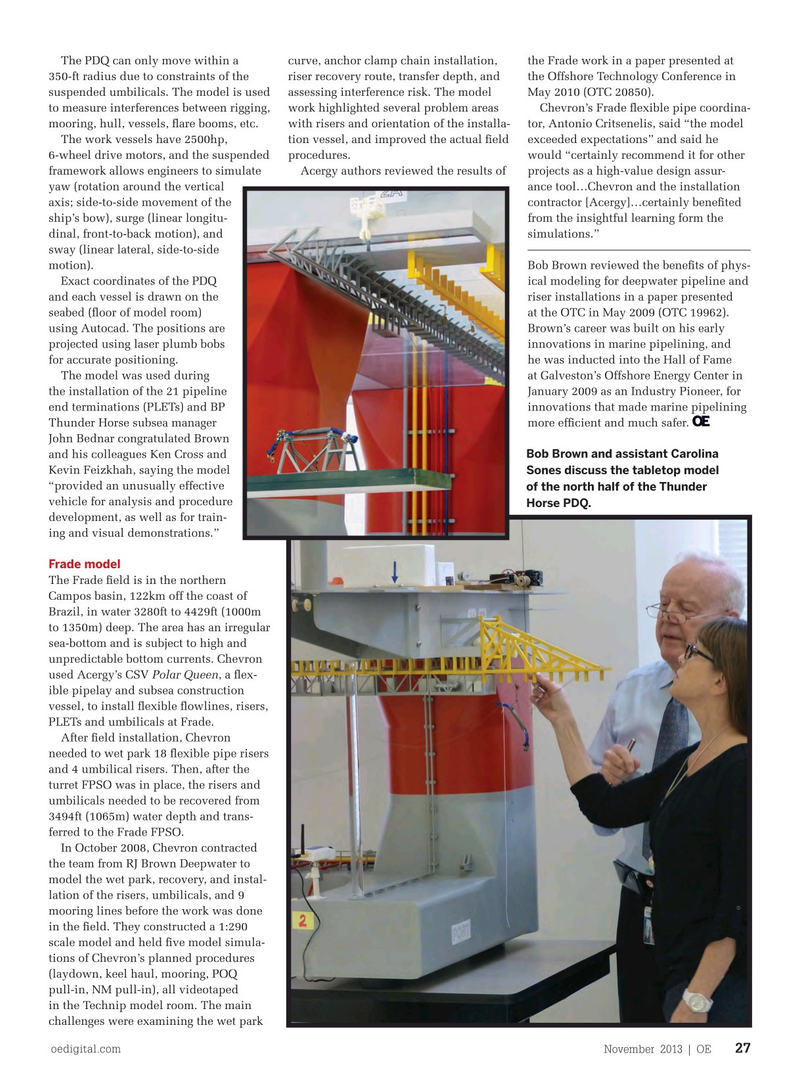
Page 25: of Offshore Engineer Magazine (Nov/Dec 2013)
Read this page in Pdf, Flash or Html5 edition of Nov/Dec 2013 Offshore Engineer Magazine
The PDQ can only move within a curve, anchor clamp chain installation, the Frade work in a paper presented at 350-ft radius due to constraints of the riser recovery route, transfer depth, and the Offshore Technology Conference in suspended umbilicals. The model is used assessing interference risk. The model May 2010 (OTC 20850).
to measure interferences between rigging, work highlighted several problem areas Chevron’s Frade fexible pipe coordina- mooring, hull, vessels, fare booms, etc. with risers and orientation of the installa- tor, Antonio Critsenelis, said “the model
The work vessels have 2500hp, tion vessel, and improved the actual feld exceeded expectations” and said he 6-wheel drive motors, and the suspended procedures. would “certainly recommend it for other framework allows engineers to simulate Acergy authors reviewed the results of projects as a high-value design assur- yaw (rotation around the vertical ance tool…Chevron and the installation axis; side-to-side movement of the contractor [Acergy]…certainly benefted ship’s bow), surge (linear longitu- from the insightful learning form the dinal, front-to-back motion), and simulations.” sway (linear lateral, side-to-side motion). Bob Brown reviewed the benefts of phys-
Exact coordinates of the PDQ ical modeling for deepwater pipeline and and each vessel is drawn on the riser installations in a paper presented seabed (foor of model room) at the OTC in May 2009 (OTC 19962). using Autocad. The positions are Brown’s career was built on his early projected using laser plumb bobs innovations in marine pipelining, and for accurate positioning. he was inducted into the Hall of Fame
The model was used during at Galveston’s Offshore Energy Center in the installation of the 21 pipeline January 2009 as an Industry Pioneer, for end terminations (PLETs) and BP innovations that made marine pipelining
Thunder Horse subsea manager more effcient and much safer.
John Bednar congratulated Brown and his colleagues Ken Cross and Bob Brown and assistant Carolina
Kevin Feizkhah, saying the model Sones discuss the tabletop model “provided an unusually effective of the north half of the Thunder vehicle for analysis and procedure
Horse PDQ.
development, as well as for train- ing and visual demonstrations.”
Frade model
The Frade feld is in the northern
Campos basin, 122km off the coast of
Brazil, in water 3280ft to 4429ft (1000m to 1350m) deep. The area has an irregular sea-bottom and is subject to high and unpredictable bottom currents. Chevron used Acergy’s CSV Polar Queen, a fex- ible pipelay and subsea construction vessel, to install fexible fowlines, risers,
PLETs and umbilicals at Frade.
After feld installation, Chevron needed to wet park 18 fexible pipe risers and 4 umbilical risers. Then, after the turret FPSO was in place, the risers and umbilicals needed to be recovered from 3494ft (1065m) water depth and trans- ferred to the Frade FPSO.
In October 2008, Chevron contracted the team from RJ Brown Deepwater to model the wet park, recovery, and instal- lation of the risers, umbilicals, and 9 mooring lines before the work was done in the feld. They constructed a 1:290 scale model and held fve model simula- tions of Chevron’s planned procedures (laydown, keel haul, mooring, POQ pull-in, NM pull-in), all videotaped in the Technip model room. The main challenges were examining the wet park oedigital.com November 2013 | OE 27 026_OE1113_vis2.indd 27 10/28/13 10:38 AM

 24
24

 26
26